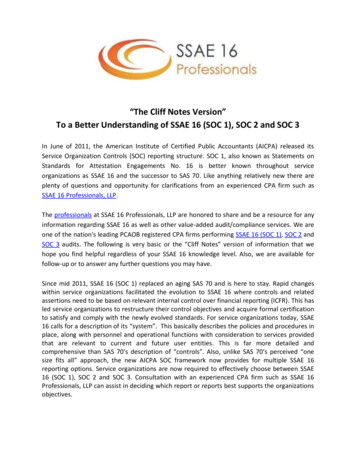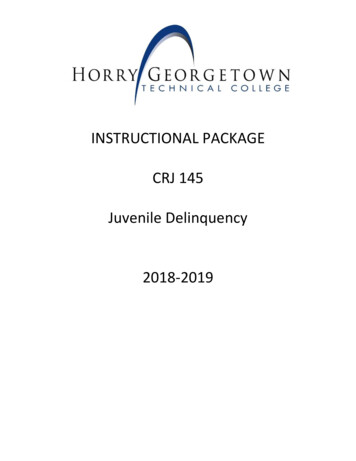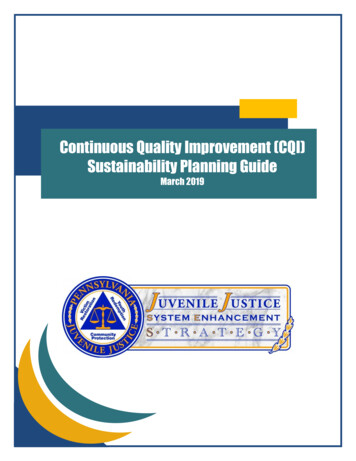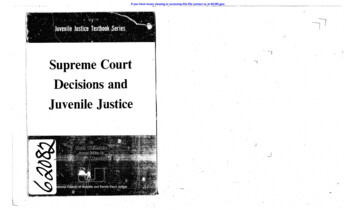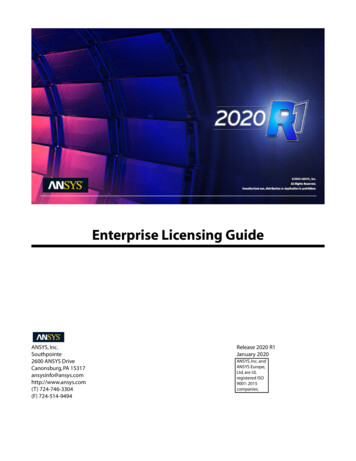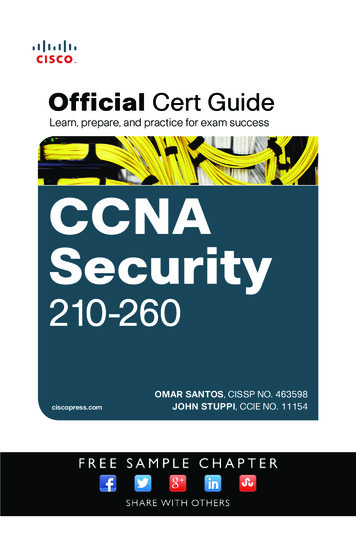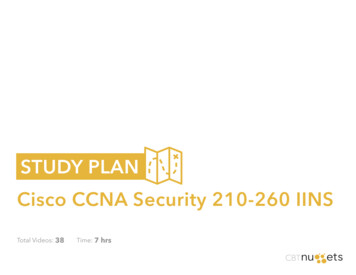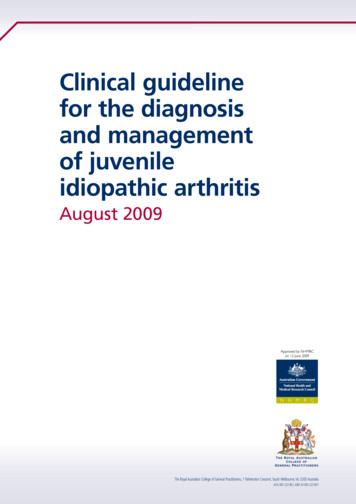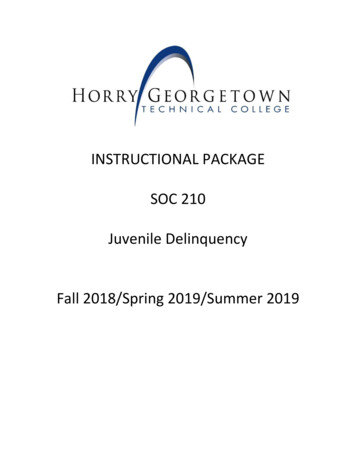
Transcription
INSTRUCTIONAL PACKAGESOC 210Juvenile DelinquencyFall 2018/Spring 2019/Summer 2019
INSTRUCTIONAL PACKAGEPART I: COURSE INFORMATIONEffective Term: Fall 2018-Spring 2019-Summer 2019COURSE PREFIX: SOC 210COURSE TITLE: Juvenile DelinquencyCONTACT HOURS: 3CREDIT HOURS: 3RATIONALE FOR THE COURSE:This course will examine juvenile delinquency from a sociological perspective to explain how itis defined, explained and controlled.COURSE DESCRIPTION:This course presents the nature, extent, and causes of juvenile delinquency behavior, includingstrategies used in the prevention, intervention, and control of deviant behavior.PREREQUISITES/CO-REQUISITES:(Credit level SOC 101 Minimum Grade of C or Credit level SOC 101 Minimum Grade of TC)*Online/Hybrid courses require students to complete the DLi Online Student Orientation priorto completing an online course. The DLi Online Student Orientation can be found in WaveNet,under the My Student tab.REQUIRED MATERIALS: Juvenile Delinquency in a Diverse Society; Bates and Swan; Sage PubPlease visit the Bookstore online site for most current textbook information. Use the direct linkbelow to find textbooks.BOOKSTORE.Enter the semester, course prefix, number and section when prompted and you will be linkedto the correct textbook.TECHNICAL REQUIREMENTS:Access to Desire2Learn (D2L), HGTC’s student portal for course materials.WaveNet and D2L email access.STUDENT IDENTIFICATION VERIFICATIONStudents enrolled in online courses will be required to participate in a minimum of one (1)proctored assignment and/or one (1) virtual event to support student identification verification.Please refer to your Instructor Information Sheet for information regarding this requirement.6/28/17 ADA
CLASSROOM ETIQUETTE:Students are required to read the textbook assignments. The text will introduce you to keyconcepts, principles, and methods devised to describe and explain juvenile delinquency in oursociety. Students are also encouraged to take notes. This course is designed to fosterinteraction, active learning and the sharing of ideas and information. Therefore, as a student,you are encouraged to participate and to be respectful of other students and the instructor.(Please be respectful when others are presenting, and asking questions. Therefore, do notengage in disruptive behavior and/or talking during class presentations and lectures). Thisdirective is part of the standard of acceptable behavior for this class. Students in violation ofthis directive may be asked to leave the class for the remainder of the class period, andsubsequently referred to the Chief Student Services Officer for further disciplinary action. For adetailed explanation of The Student Code for The South Carolina Technical College System,please refer to the College Catalog (available Online). The faculty and administration of HGTCare committed to enhancing your learning experience at the College through improvedmethods of instruction and support services.As a matter of courtesy to other students and your professor, please turn off cell phones andother communication/entertainment devices before class begins. If you are monitoring for anemergency, please notify your professor prior to class and switch cell phone ringers to vibrate.ONLINE/HYBRID COURSES:NETIQUETTE is the term commonly used to refer to conventions adopted by Internet users on theweb, mailing lists, public forums, and in live chat focused on online communications etiquette.For more information regarding Netiquette expectations for distance learning courses, pleasevisit: Online Netiquette.POLICY REGARDING ACADEMIC MISCONDUCT (WHICH INCLUDES CHEATING ON TESTS,PLAGIARISM, AND FALSIFICATION OF INFORMATION)Please review the "Student Rights and Responsibilities, Academic Misconduct" in the HorryGeorgetown Technical College Catalog and Student Handbook available in hardcopy and Online.Classroom conduct: It is the responsibility of faculty to clearly communicate classroomexpectations early in the semester. If, after that communication, students are unwilling tocomply with expectations and have been notified of the unacceptability of such conduct, facultyshould: First offense of disruptive behavior-Dismiss student from class “for a period” untildiscussion concerning acceptable conduct and next steps can occur between faculty andstudent. Student should not be readmitted to class until such discussion occurs. Second offense of disruptive behavior-Dismiss student from class (or request PublicSafety assistance for removal) for written referral to Chief Student Services Officer fordisciplinary follow up.Academic Misconduct: Cheating, plagiarism, collusion, et al. Professor must meet with student to discuss allegation and evidence upon which it isbased. The student must be given the opportunity to refute the allegation.6/28/17 ADA
If academic misconduct is substantiated to the Professor’s satisfaction, the Professornotifies the student of the sanction to be imposed, consisting of one of the following: Assign a grade of zero to the test, assignment, etc. involved in the academicmisconduct. Assign a failing grade for the course (with consultation on student academicoptions including the appeal process) Require the student to withdraw from the course Within five (5) working days of the meeting with the student, the Professor mustprovide a written explanation of the incident and any sanction imposed to the ChiefInstructional Office. Please also notify the CSSO, as the CSSO serves as the CIO designee forappeal processing.Part II: Student Learning OutcomesCOURSE LEARNING OUTCOMES and ASSESSMENTS*:Course Learning Outcomes: Define juvenile delinquency and explain how it is socially constructed. Explain juvenile delinquency by applying sociological theoretical approaches. Describe the social contexts of juvenile delinquency. Critically evaluate societal responses to juvenile delinquency.Learning Outcomes:Chapter 1 Describe why juveniles are treated differently than adults Explain the difference between juvenile delinquency and status offenses Summarize the three conceptions of delinquency and how they relate to our responses tojuvenile delinquency Identify the social context in which juveniles are living and its effect on the well-being ofchildren Compare and contrast the concepts of individual and institutional racism, classism, and sexism Explain why intersectionality is important Describe the role of the sociological imagination in explaining the societal response to juveniledelinquencyChapter 2 Describe how the concept of juvenile delinquency developed over the course of U.S. historybefore culminating in the creation of the first juvenile justice system Explain how different forms of popular culture have been the focus of moral panics aboutdelinquency Analyze the connections between social constructions of youth and mainstream ideas aboutjuvenile misbehavior Compare and contrast ideas about youth and juvenile delinquency related to one’s race,ethnicity, social class, gender, and sexualityChapter 3 Describe what is needed to create a good statistic (gather good data) Explain the difference between quantitative and qualitative data6/28/17 ADA
Explain the correlates of delinquencyExplain the strengths and weaknesses of each data sourceExplain the trends in delinquency (violence, property, and drug crimes)Analyze the race differences in trends in delinquency (violence, property, and drug crimes)Analyze the gender differences in trends in delinquency (violence, property, and drug crimes)Compare and contrast the type of data used in our understanding of the correlates and trends indelinquency*Suggested Outline:Unit 1Materials Covered:*Assessment(s):Understanding Juvenile DelinquencyChapter 1Chapter 2Chapter 3Complete class activities, handouts, homework assignments and/or quizzes.Unit ExamChapter 4 Describe the process of differential association Describe the difference between differential association and social learning theories Explain the social bonds in social control/social bonding theory Explain the processes in life course theory Analyze the three types of strain in general strain theory Analyze the coping strategies in general strain theory and the place of delinquency in thosecoping strategies Compare and contrast differential association, social control, and general strain theories Compare and contrast the merits of the theories for explaining these race, class, and genderdifferencesChapter 5 Explain why social structural theories of delinquency are considered sociological positivisttheories Distinguish between Durkheim’s and Merton’s versions of anomie theory Outline the roots of social disorganization theories and their fundamental assumptions Identify the primary ways social structural theories of delinquency address race, gender, andclass Relate social structural theories of delinquency to possible policy interventionsChapter 6 Explain the commonalities of all critical theories Summarize labeling theory’s origins and key concepts Outline the major conflict theories of delinquency and their key concepts Identify multiple feminist theories and their respective emphases Assess how critical theories address the relationship between race, ethnicity, social class,gender, sexuality, and delinquency Analyze the relevance of critical theories of delinquency to public policy6/28/17 ADA
*Suggested Outline:Unit 2Materials Covered:*Assessment(s):Theories of Juvenile DelinquencyChapter 4Chapter 5Chapter 6Complete class activities, handouts, homework assignments and/or quizzes.Unit ExamChapter 7 Describe the nature and extent of family trends, including marriage, divorce, and unmarriedbirth rates Explain the complicated relationship between family structure and delinquency Explain the impact of family process on the relationship between family structure anddelinquency Explain the impact of family process on delinquency Explain the nature and extent of child maltreatment Analyze the complicated relationship between child maltreatment and delinquency Explain the relationship between child maltreatment, parental incarceration, and theexperiences in foster care for youthChapter 8 Describe the trends in education in the United States Explain how gender and race impact these trends Explain how a changing budget impacts the educational system, learning, and delinquency Explain the impact of school failure on delinquency Analyze the contextual factors of tracking, alienation, and social class on failure in school Compare and contrast the nature and extent of violence and property crime in schools Compare and contrast the nature and extent of bullying and cyberbullying in schools Compare and contrast the impact of increased social control in schools on student experiencesand delinquencyChapter 9 List the two primary hypotheses about how peers and friends matter to delinquency Explain how gender matters to patterns of peer relationships and delinquency Outline the impact of a lack of friends on delinquency Discuss the different ways youth are using new technologies and their relevance to delinquency Analyze the consequences of labeling a group of youth as a gang Identify how race, ethnicity, class, gender, and sexuality play a role in gang formation anddynamics Recognize the most common societal responses to youth gangs and their consequencesChapter 10 Discuss the reasons for youth drug use and societal understandings of substance use Provide illustrations of the role of legal products in youth substance use Analyze the general pattern and trends of youth drug use in the United States today, as well aspatterns related to gender, race, and ethnicity Explain the effects of drug prohibition and the war on drugs Examine the relationship between drug and alcohol use and delinquency and how it can be6/28/17 ADA
affected by sexism, racism, homophobia, and transphobiaCompare and contrast societal responses to youth drug use, including the use of culturallyspecific approaches*Suggested Outline:Unit 3Materials Covered:*Assessment(s):Social Contexts of Juvenile DelinquencyChapter 7Chapter 8Chapter 9Chapter 10Complete class activities, handouts, homework assignments and/or quizzes.Unit ExamChapter 11 Define the philosophical goal of juvenile justice systems Analyze the various justifications for punishment and how they have been used to respond tothe behaviors of youth Explain the philosophical shifts that have affected the legal treatment of juveniles in the UnitedStates Identify current concerns and trends that will shape the future of juvenile justiceChapter 12 Describe the roles of law enforcement Explain the stages of the juvenile justice system Explain cumulative disadvantage Analyze the relationship between race/ethnicity and unequal treatment in the juvenile justiceprocess Analyze the relationship between gender and unequal treatment in the juvenile justice process Compare and contrast the juvenile justice process and the juvenile dependency processChapter 13 Describe the correctional alternatives Explain the difference between secure and open correctional facilities Analyze the current problems that characterize juvenile correctional facilities Compare and contrast the impact of gender, race and ethnicity, and sexual orientation on theexperiences of youth in the correctional systemChapter 14 Describe examples of delinquency prevention methods and programs Explain how specific types of youth rehabilitation programs operate Discuss the most popular forms of restorative justice used with young people Analyze race, class, and gender concerns related to prevention, rehabilitation, and restoration List the components of a comprehensive juvenile delinquency program Outline possible future directions in preventative, rehabilitative, and restorative justiceapproaches to youth and delinquency*Suggested Outline:6/28/17 ADA
Unit 4Materials Covered:*Assessment(s):Responses to Juvenile DelinquencyChapter 11Chapter 12Chapter 13Chapter 14Complete class activities, handouts, homework assignments and/or quizzes.Unit Exam*Students – please refer to the Instructor’s Course Information sheet for specific informationon assessments and due dates.Part III: Grading and AssessmentAll tangible measurements used for assessment of student course learning outcomes are atthe discretion of the instructor and should be specifically outlined by the instructor.Suggested methods appropriate for this course can include but are not limited to thefollowing: discussion questions, assignments, portfolios, written comprehensive exams,papers and group projects.EVALUATION OF REQUIRED COURSE MEASURES/ARTIFACTS*Students’ performance will be assessed and the weight associated with the variousmeasures/artifacts are listed below.EVALUATION*Exams (2 to 5 Examsincluding FinalExam if rojects/PortfoliosClass participation40%-80%10%-30%10%-30%0%-10%Total (must add up to 100%)*Students, for the specific number and type of evaluations, please refer to the Instructor’sCourse Information Sheet.GRADING SYSTEM:State the College’s or departmental grading system as delineated in the Catalog. Please notethe College adheres to a 10 point grading scale A 100 – 90, B 89- 80, C 79 – 70, D 69 – 60,F 59 and below. You must have your Dean’s approval if changes in the scale are made.Grades earned in courses impact academic progression and financial aid status. Beforewithdrawing from a course, be sure to talk with your instructor and financial aid counselor6/28/17 ADA
about the implications of that course of action. Ds, Fs, Ws, WFs and Is also negatively impactacademic progression and financial aid status.The Add/Drop Period is the first 5 days of the semester for full term classes. Add/Drop periodsare shorter for accelerated format courses. Please refer to the academic calendar for deadlinesfor add/drop (ACADEMIC CALENDAR). You must attend at least one meeting of all of yourclasses during that period. If you do not, you will be dropped from the course(s) and yourFinancial Aid will be reduced accordingly.Part IV: AttendanceHorry-Georgetown Technical College maintains a general attendance policy requiring studentsto be present for a minimum of eighty percent (80%) of his or her classes in order to be eligibleto receive credit for any course. However, due to the varied nature of courses taught at theCollege, a more rigid attendance policy may be required by individual instructors. At aminimum, a student may be withdrawn from a course(s) after he or she has been absent inexcess of ten percent (10%) of the total contact hours for a course. Instructors define absenteelimits for their class at the beginning of each term; please refer to the Instructor CourseInformation Sheet.For online and hybrid courses, check your Instructor’s Course Information Sheet for anyrequired on-site meeting times. Please note, instructors may require tests to be taken atapproved testing sites, if you use a testing center other than those provided by HGTC, thecenter may charge a fee for its services.Part V: Student ResourcesThe Student Success and Tutoring Center (SSTC)The SSTC offers to all students the following free resources:1. Academic coaches for most subject areas, Writing Center Support, and college successskills.2. On-line student success and academic support resources.Visit the SSTC website: Student Success & Tutoring Center and visit the student services tab inyour WaveNet account to schedule appointments using TutorTrac. For more information, call:SSTC Conway, 349-7872; SSTC Grand Strand, 477-2113; and SSTC Georgetown, 520-1455.Room locations and Live Chat is available on the SSTC website.6/28/17 ADA
Student Information Center: WaveNet Central (WNC)WNC offers to all students the following free resources:1. Getting around HGTC: General information and guidance for enrollment!2. Use the Online Resource Center (ORC) for COMPASS support, technology education, and onlinetools.3. Drop-in technology support or scheduled training in the Center or in class.4. In-person workshops, online tutorials and more services are available.Visit the WNC website: Wavenet Central. Live Chat and Center locations are posted on the website. Orplease call one of the following locations: WNC Conway, 349-5182; WNC Grand Strand, 477-2076; andWNC Georgetown, 520-1473.Student Testing: (If course is offered in multiple format include this section, delete if onlyF2F sections are offered.)Testing in an online/hybrid course may be accomplished in a variety of ways: Test administered within D2L Test administered in writing on paper Test administered through Publisher PlatformsFurther more tests may have time limits and/or require a proctor.Proctoring can be accomplished either face-to-face at an approved site or online throughRPNow, our online proctoring service. To find out more about proctoring services, please visitthe Online Testing section of the HGTC’s Testing Center webpage.The Instructor Information Sheet will have more details on test requirements for your course.Disability ServicesHGTC is committed to providing an accessible environment for students with disabilities. Inquiries maybe directed to Jocelyn Williams, Director of Student Development on the Conway Campus Jaime Davis,Counselor/Advisor on the Georgetown Campus or Kristin Griffin, Counselor on the Grand StrandCampus. These individuals will review documentation of the student’s disability and, in a confidentialsetting with the student, develop an educational accommodation plan.Note: It is the student’s responsibility to self-identify as needing accommodations and to provideacceptable documentation. After a student has self-identified and submitted documentation of adisability, accommodations may be determined, accepted, and provided.6/28/17 ADA
Statement of Equal Opportunity/Non-Discrimination StatementHorry Georgetown Technical College prohibits discrimination and harassment, including sexualharassment and abuse, on the basis of race, color, gender, national or ethnic origin, age, religion,disability, marital status, veteran status, sexual orientation, gender identity, or pregnancy in educationalprograms and/or activities.Title IX RequirementsHorry Georgetown Technical College prohibits the offenses of domestic violence, dating violence, sexualassault, and stalking. Any student who believe he or she has experienced or witnessed discriminationincluding sexual harassment, domestic violence, dating violence, sexual assault or stalking is encouragedto report such incidents to one of the College’s Title IX Coordinators.*Faculty and Staff are required to report incidents to the Title IX Coordinators when involvingstudents. The only HGTC employees exempt from mandatory reporting are licensed mentalhealth professionals (only as part of their job description such as counseling services).Inquiries regarding the non-discrimination policies:Student and prospective student inquiriesconcerning Section 504, Title II, and Title IX andtheir application to the College or any studentdecision may be directed to the Associate VicePresident for Student Affairs.Dr. Melissa Batten, AVP Student AffairsTitle IX CoordinatorBuilding 1100, Room 107A, Conway CampusEmployee and applicant inquiries concerningSection 504, Title II, and Title IX and theirapplication to the College may be directed to theAssociate Vice President for Human Resources.PO Box 261966, Conway, SC 29528-6066PO Box 261966, Conway, SC 49-5212Jacquelyne.Snyder@hgtc.edu6/28/17 ADAJacquelyne Snyder, AVP Human ResourcesSection 504, Title II, and Title IX CoordinatorBuilding 200, Room 212A, Conway Campus
6/28/17 ADA CLASSROOM ETIQUETTE: Students are required to read the textbook assignments. The text will introduce you to key concepts, principles, and methods devised to describe


